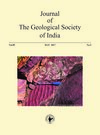Mineralogy, Petrography and Micro-chemical Characteristics of Enclaves of Mylonitic BIFs within Sukinda Ultramafic Complex, Odisha
DOI:
https://doi.org/10.1007/s12594-017-0642-7Abstract
Elongated NE-SW trending bodies of iron-rich rock are exposed adjacent to pyroxenite dyke within Sukinda ultramafic complex, Odisha. Field study followed by optical and electron microscopy, XRD and EPMA investigation reveal the rocks to be fine grained, weathered, limonitised; containing quartz, magnetite, hematite/ martite and goethite. The rock has suffered from deformation during intrusion of chromiferous magma. It rarely shows banding/ lamination, but largely exhibits mylonitic fabric, resulting from magmatic intrusion. The stronger deformation is evident from subgrain formation, deformed mineral grains; often with orientation, stretching (boudinage) and shortening (folding); presence of porphyroclasts, pull-apart structure, undulose extinction, dynamic recrystallisation etc. From the microstructure and mineral abundance, the rock is designated as "Mylonitic Magentite Quartzite" (MMQ).
Enrichment of some elements like Ni, Mg, Cr in the magnetite phase of MMQ is attributed to solid state diffusion of these elements from chromiferous mafic magma during thermal metamorphism. This is determined from electron probe microanalysis of ironrich phase in MMQ, which is found to contain 88-90 wt% of FeO(t) with ~1%, NiO, ~1%, MgO and 0.1% Cr2O3 having around 3 mole% of trevorite; 4-6% of magnesioferrite; 0.15-0.3% of chromite; 86-87% of magnetite and 3-4% of wustite. Considering presence of wustite as temperature indicator, the temperature of magma envisaged to be around 950-1100°C.
In a later period, the MMQ has undergone oxidation and lateritisation owing to its prolonged exposure. During this process, new minerals like hematite and goethite substituted magnetite, resulting leaching of iron (FeO: 62-68%) and magnesium (MgO: 0.1-0.35) and enrichment of chromium (Cr2O3:4-7%) and nickel (NiO: 1.6-2.3%). The silica (SiO2: 4-5%), alumina (Al2O3:~1%) are contributed by kaolinite, formed during lateritisation.
The field and laboratory studies confirm these iron-rich exposures to be enclaves of BIFs, banded magnetite quartzite (BMQ) in particular, within the Sukinda chromiferous ultramafic complex. Micro-structural features and microchemical composition of iron minerals in these exposures are interpreted as the influence of forceful ultramafic intrusion into the existing BMQ and effect of thermal metamorphism followed by oxidation, weathering/lateritisation.
Downloads
Metrics
Issue
Section
Downloads
Published
How to Cite
References
Acharya, S. (1984) Statigraphy and structural evolutions of the rocks of iron Ore basin in Singhbhum, India. Indian Jour. Earth Sci. CEISM, pp.19-28.
Banerjee, P.K. (1972). Geology and geochemistry of the Sukinda ultra-mafic field, Cuttack district, Orissa. Mem. Geol. Surv. India, v.103, 171p.
Basu, A., Maitra, M. and Roy, P.K. (1997) Petrology of mafic ultramafic complex of Sukinda valley, Orissa. Indian Minerals, v.50, pp.271-290.
Briones, R., Villar, I C De, Ramon and Hernandez Lunar, Rosario (2007) Crystallographic preferred orientation and microstructure of a Variscan marble mylonite in the Osea-Morena Zone (SW Iberia). Jour. Struct Geol., v.29, pp.1353-1368.
Chakraborty, K.L.(1972) Some primary structures in some Chromitite of Orissa, India. Mineralium Deposita (Berl), v.7, pp.280-284.
Chakraborty, K.L and Baidya, T. (1978) Geological setting and mineralogy of the chromite and some associated minerals of Kathpal, Dhenkanal district, Orissa. Jour. Geol. Soc. India, v.19, pp.303-309.
Chakraborty, K.L., Chakraborty, T.L. and Majumder, T. (1980) Stratigraphy and structure of the Pre-Cambrian Banded Iron Formation and chromite bearing ultramafic rocks of Sukinda valley, Orissa. Jour. Geol. Soc. India, v.21, pp.398-404.
Chakraborty, K.L. and Chakraborty, T.L. (1984) Geological features and origin of the chromite deposits of Sukinda valley, Orissa, India. Miner. Dep., v.19, pp.256-265.
Chakraborty, K.L. and Chakraborty, T.L. (1985) Chromite ore bodies- their structures and textures. Indian Minerals, v.36, pp.1-13.
Michal Krzyanowski, John H.Beynon and Didier C. J. Farrugia (2010) Oxide scale behavior in high temperature metal processing. WILEY-VCH Verlag GmbH & Co, 386p.
Monograph on Chromite (2013) Indian Bureau of Mines, Nagpur
Mousa, E.A. (2014) Effect of basicity on wustite sinter reducibility under simulated blast furnace condition. Iron Making & Steel Making: Process, Products and Applications, v.41(6).
Mondal, S.K., Ripleyb, E.M., Lib Chusi, Frei Robert (2006) The genesis of Archaean chromitites from the Nuasahi and Sukinda massifs in the Singhbhum Craton, India. Precambrian Res., v.148, pp.45-66
Page, N.J., Banerjee, P.K. and Haffty, J. (1985) Characterization of the Sukinda and Nausahi ultramaí»c complex, Orissa, India by platinum-group element geochemistry. Precambrian Res., v.30, pp.27–41
Srinivasachari, K. (1979) Stratiform Chromite deposits of Sukinda-Nuasahi ultramafic belt, Orissa, India. In: Tectonics and Metallogeny of south and East Asia. Geol. Surv. India Misc., v.34, pp.151-159.
Sharma, P., Mohapatrab, K. and Singh, P.P. (2013)Dispersion Pattern of PGE and Ag in chromiferous ultramafic suite of rocks in Sukinda valley, India. Resource Geol., v.63, pp.371-383.
Upadhyay, R.K., Mohanty, R., Mallick, P. and Suresh Kumar, T.S. (2009). Controls of Mineralisation and application of suitable exploration techniques for evaluation of magmatic deposit: A case study from Sukinda Chromite deposit. Proc. Int. Sem. on Magmatic Ore Deposits (ISMO), Bhubaneswar.

 P. Sharma
P. Sharma






